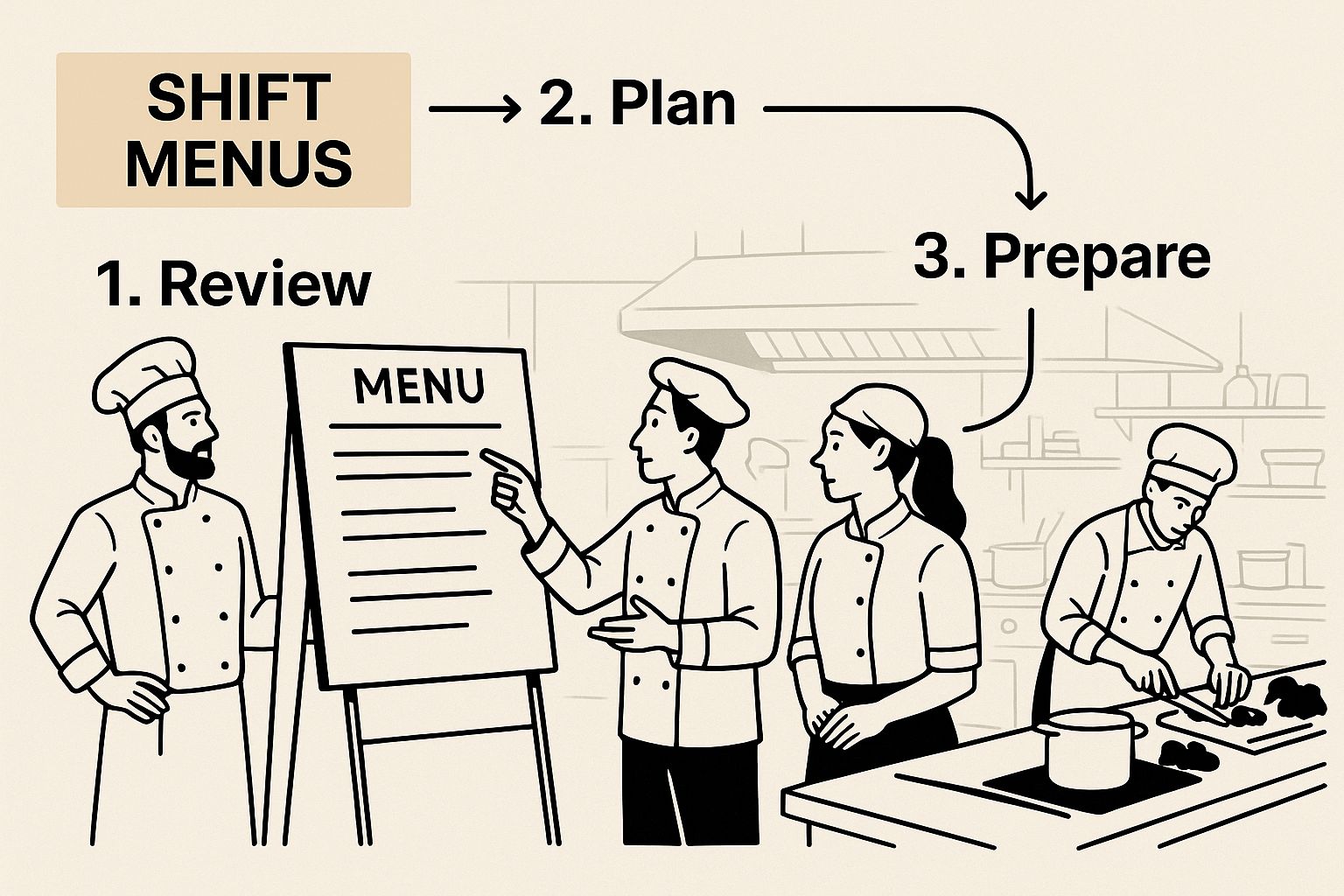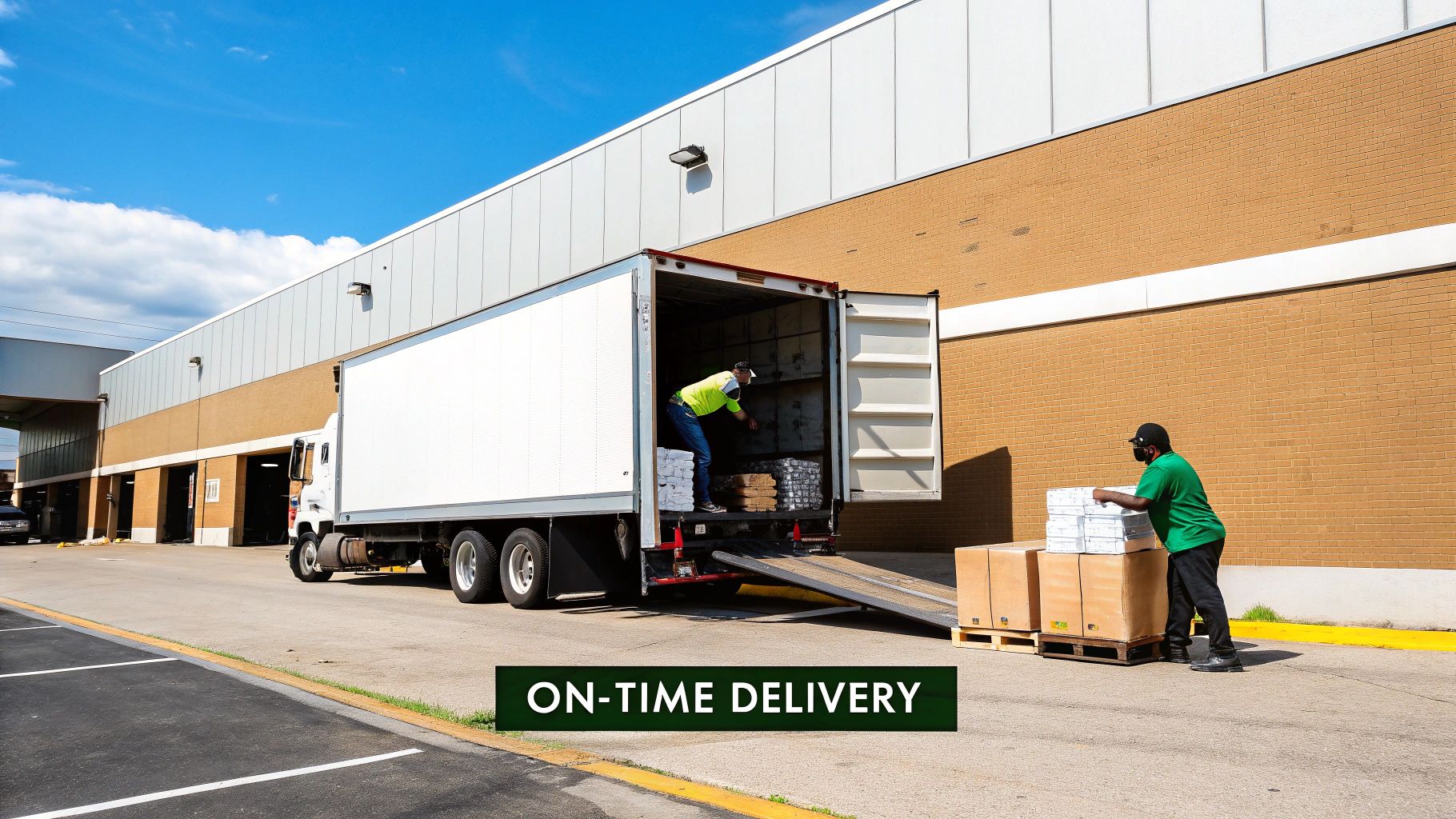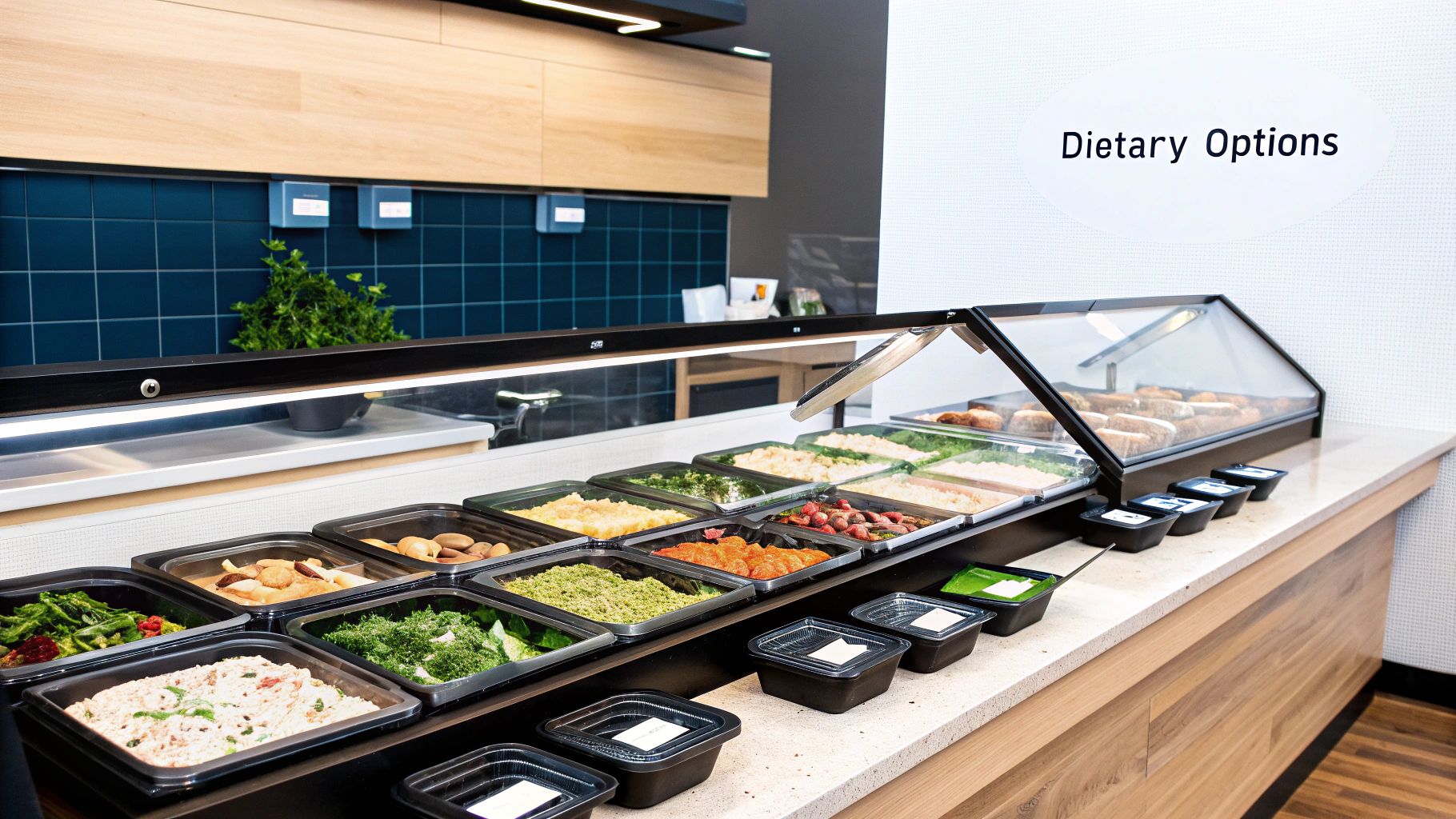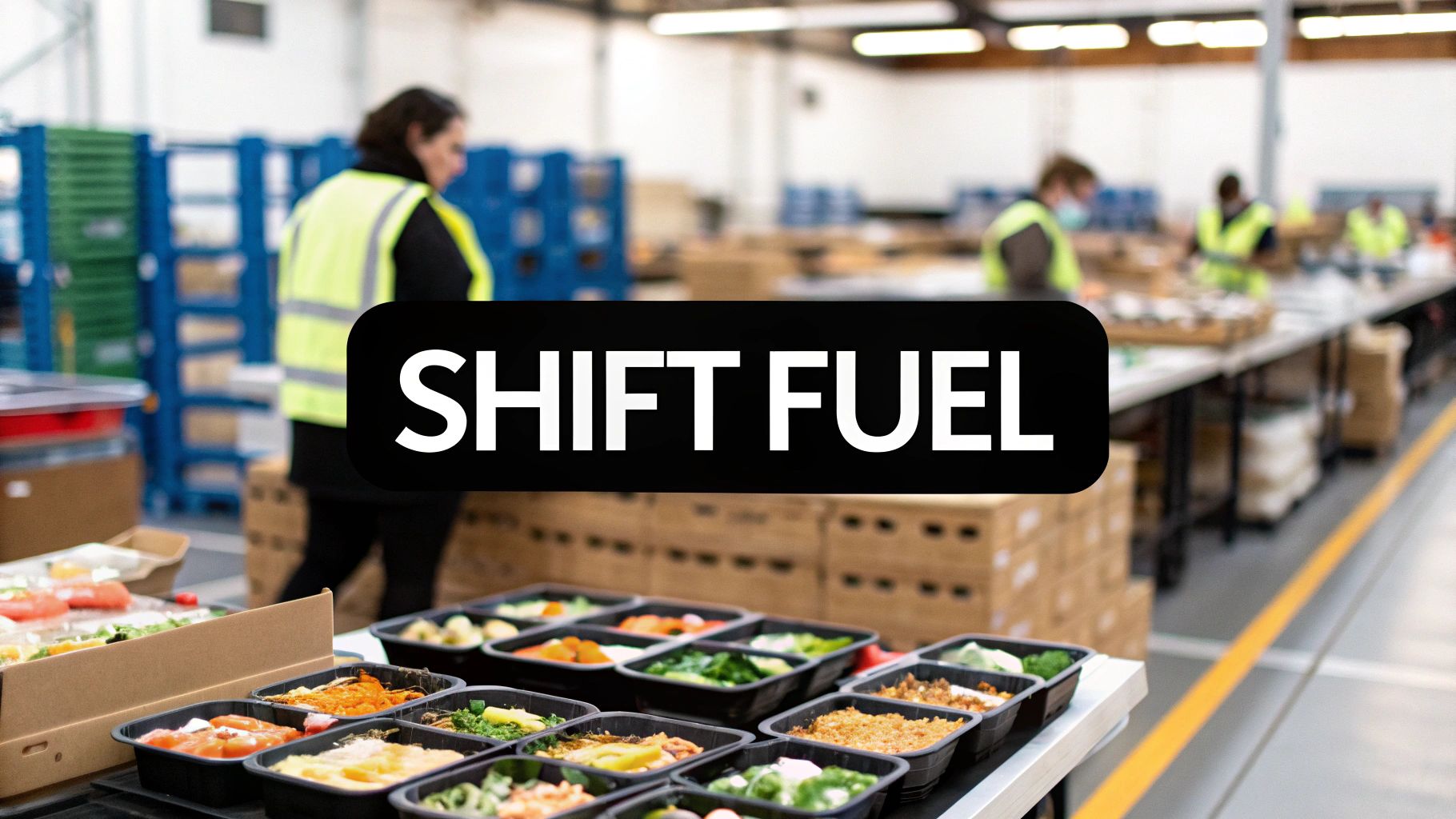Warehouse shift-based catering is all about making sure your employees who work odd hours—like the night or swing shifts—get good food. It’s not just about dropping off meals. It's a smart way to keep morale high, focus sharp, and productivity humming along, especially in a 24/7 operation where you need all your team members at their best.
Why Smart Catering Is a Non-Negotiable Asset
Keeping a warehouse running smoothly around the clock is a huge undertaking. When managers picture operational excellence, they usually think of inventory systems, logistics, and machinery. But one of the most overlooked—and most critical—factors is how you fuel your people.
Think of your workforce as a high-performance engine. You wouldn't put cheap, inconsistent fuel in it and expect it to run without breakdowns or slowdowns. The same goes for your team. When the night shift is stuck with vending machine snacks or lukewarm fast food because nothing else is open, their energy and focus are bound to dip. This isn't just a small inconvenience; it hits your bottom line directly.
Moving Beyond a Perk to a Performance Tool
A well-planned warehouse catering program isn’t a cost centre; it's a strategic investment in the stability of your entire operation. By providing consistent, nutritious meals, you're tackling some of the most common pain points in a warehouse head-on.
A thoughtful catering strategy does more than fill stomachs. It sends a clear message to every employee, on every shift, that their well-being is a priority. That builds a kind of loyalty and resilience that no piece of technology can replicate.
This approach is absolutely essential in logistics and manufacturing hubs where multiple shifts create a need for flexible meal solutions. In Canada, for example, the catering industry plays a huge role in supporting these sectors. Corporate catering makes up a significant slice of the market, and its ability to adapt to complex schedules directly impacts warehouse productivity and worker satisfaction. You can dig into Canada's catering industry dynamics and discover key insights on IBISWorld.com.
The Tangible Benefits of a Well-Fed Team
Putting a structured catering plan in place delivers real, measurable advantages that go way beyond the breakroom. It's a proactive step toward building a more resilient and motivated workforce.
Here are some of the key benefits:
- Reduced Absenteeism: When your team has reliable access to quality food, their overall health improves, which often means fewer sick days.
- Sharpened On-Floor Focus: Proper nutrition helps prevent the energy crashes that can lead to costly mistakes and even safety incidents.
- Enhanced Team Morale: There's nothing like making the night crew feel just as valued as the day shift by providing them with the same great meals. It fosters a genuine sense of equity and appreciation.
At the end of the day, investing in your team's nutrition is an investment in your operational success. If you're looking for ideas that won't break the bank, check out our guide on how to feed your warehouse team for under $10 per person in Toronto.
Building Your Around-the-Clock Catering Blueprint
Crafting a catering program for a 24/7 warehouse isn't just about ordering food. It's a logistical puzzle. Think of it like building a detailed operational plan—you need a data-driven blueprint that respects the unique rhythm of each and every shift.
Throwing the same heavy lasagna at the day crew and the night crew just doesn't work. It's a surefire way to get sluggish workers and a lot of complaints. A plan that actually succeeds starts with one simple thing: understanding the distinct needs of your people, around the clock.
First things first, you need to map out your team's real requirements. This goes way beyond a simple headcount. You have to dig into the details that make each shift different. How many people are on the floor at 2 p.m. versus 2 a.m.? When are the peak break times for each group? Answering these questions builds the foundation you need to understand demand.
This visual gives a great overview of how to structure a catering plan that matches the different energy needs and schedules across multiple shifts.

Seeing it laid out like this really drives home why customizing menus and delivery times is so critical. The goal is to support your team's well-being and workflow, not disrupt it.
Assessing Your Unique Shift Needs
To get a plan that truly fits your operation, you need to collect some specific information. Your blueprint should be built on a solid assessment of who you're feeding and when. This is how you avoid waste and make sure the catering is something your team actually looks forward to.
Start by getting answers to these crucial questions:
- Headcount Fluctuations: Does your headcount change a lot between the day, swing, and night shifts?
- Dietary Needs: What allergies, dietary restrictions (like halal or vegetarian), and general preferences pop up on each shift? A simple survey can give you incredibly valuable insights.
- Budget Allocation: Does your budget need to be split differently across shifts, or are you working with a flat per-person rate?
Once you have these answers, you're no longer just guessing. You have the framework for a practical, cost-effective catering program that treats everyone fairly.
To help you organize this, here's a checklist to walk through the specific needs of each shift. It's a simple way to make sure you haven't missed anything important.
Shift-Based Catering Needs Assessment Checklist
| Planning Factor | Day Shift Considerations | Swing Shift Considerations | Night Shift Considerations |
|---|---|---|---|
| Headcount | Typically highest. Need to confirm exact numbers for peak attendance. | Often variable. Confirm overlap with day/night shifts. | Usually smaller, more consistent crew. Double-check for weekend variations. |
| Meal Type | Hearty, balanced lunch to sustain energy. Lighter breakfast options. | Dinner-style meal. Can be a transition between lunch and late-night food. | Lighter, easily digestible meals. Avoid heavy, greasy food that causes fatigue. |
| Energy Needs | Focus on slow-release carbs and protein for sustained physical work. | Energy boost needed for the second half of the day. Mix of carbs and protein. | High-protein, low-sugar options to maintain alertness and avoid a crash. |
| Dietary Needs | Collect data on allergies, vegetarian, vegan, halal, etc. | Survey the team specifically; don't assume they are the same as the day shift. | This crew is often overlooked. Make a special effort to get their preferences. |
| Break Times | Staggered or unified lunch breaks? Plan for peak rush. | Breaks often occur during typical dinner hours (6-8 p.m.). | Unconventional break times (e.g., 2-3 a.m.). Ensure food is fresh. |
| Logistics | Easier for caterers to deliver. More vendor options available. | Delivery window might be tight. Confirm caterer's operating hours. | The biggest challenge. Very few caterers offer reliable 24/7 service. |
Using a checklist like this ensures a systematic approach, helping you build a catering plan that genuinely supports every single member of your warehouse team, no matter when they clock in.
Navigating External Industry Challenges
It's also smart to keep an eye on the external factors hitting potential catering partners. Recent labour shortages have put a ton of pressure on the food service industry.
For example, a staggering 86% of catering companies reported being understaffed in 2024–2025, with many struggling to find enough people to meet demand. To keep their teams, 92% of caterers increased wages last year, a cost that naturally finds its way into pricing and service availability.
Being aware of these realities helps you set realistic expectations and choose a partner with a stable, reliable operation. You can dig deeper into these figures by checking out these restaurant catering statistics and trends.
Designing Menus That Fuel Performance
When it comes to feeding your warehouse team, a great menu is about so much more than just taste. Think of it as a strategic tool for boosting productivity. In the world of warehouse shift–based catering, serving the right meal at the right time can be the difference between a sluggish, unfocused team and a crew that's energised and on the ball. It’s really about applying a bit of food science to the unique demands of an industrial workforce.

Here's an analogy: you wouldn't give a marathon runner and a sprinter the exact same pre-race meal, right? It’s the same principle here. The nutritional needs of a night shift worker, whose body clock is essentially flipped upside down, are completely different from those of a day shift employee doing heavy lifting. The goal is simple: match the fuel to the task and the time of day.
For instance, a heavy, carb-loaded meal served at 2 a.m. is a recipe for drowsiness—the absolute last thing you want for a team operating machinery. Instead, night shifts do much better with lighter, protein-focused meals that keep them alert without leading to an energy crash later on.
Customizing Menus for Different Shifts
The secret lies in creating distinct nutritional plans for each shift. A one-size-fits-all approach just doesn't cut it; in fact, it can actually undermine your productivity goals. Your menu strategy needs to be as segmented as your work schedule.
Here’s a practical way to think about it:
- Day Shift: These workers often tackle the most physically demanding jobs. Their meals should be built around complex carbohydrates (like brown rice or whole grains) for lasting energy, lean proteins to support their muscles, and plenty of fresh vegetables.
- Swing Shift: As the transitional shift, these folks need a balanced meal that stops that dreaded evening energy slump in its tracks. A solid mix of protein and moderate carbs is perfect for keeping them sharp through the late hours.
- Night Shift: Here, the focus is squarely on alertness and easy digestion. Go for lighter meals packed with protein like grilled chicken or fish, healthy fats, and vegetables. Sugary drinks and heavy, greasy foods should be avoided at all costs.
A well-crafted menu acknowledges that not all work hours are created equal. By tailoring nutrition to circadian rhythms and job functions, you directly invest in the safety, focus, and well-being of every single employee.
Preventing Menu Fatigue and Embracing Diversity
Serving the same five meals on a loop is the fastest way to kill morale. "Menu fatigue" is a real thing, and it can turn a valued perk into something that feels like a chore. The solution is to introduce variety through a consistent but manageable rotation.
Try bringing in new dishes on a monthly or seasonal basis to keep things fresh. This is also a fantastic opportunity to celebrate a multicultural workforce. Adding diverse cuisines—like flavourful Middle Eastern options—not only shows respect for different backgrounds but also introduces your team to exciting new tastes. You can get some great ideas for authentic, crowd-pleasing dishes by exploring a diverse offering like the Shawarma Moose menu, which can really help break the monotony.
Finally, don’t forget the small details that make a big difference. Accessible hydration stations with water and unsweetened iced tea are crucial. Offering healthy snacks like fruit, yogurt, or nuts lets employees refuel between meals, which helps maintain stable energy levels throughout their entire shift. It's this complete approach that ensures your catering program genuinely fuels your team's performance.
Mastering the Logistics of Food Service
An incredible menu is only half the battle. If that perfectly crafted meal for the night shift arrives late or cold, the entire effort is wasted. The true test of a successful warehouse shift based catering program really comes down to mastering the operational puzzle of getting the right food to the right people, precisely when they need it.
This is where planning and execution become everything. Think of your catering delivery like a critical supply shipment arriving on your dock—it has to be on time, in perfect condition, and ready for your team to grab and go. The logistics need to be flawless to support your operations, not disrupt them. We're talking about everything from staggering delivery times to match different break schedules to maintaining exact food temperatures for safety and quality.
Selecting the Right Service Model
No two warehouses are built the same, and neither are their break rooms. Choosing a service model that actually fits your physical space and the natural flow of your workforce is crucial for a smooth experience. Each option comes with its own set of pros and cons.
Here are the main models to consider:
- Buffet Style: This classic setup is fantastic for getting people to mingle and offering a good variety. The catch? You need a dedicated, spacious area, and it can create long queues if not managed well, especially during a short break.
- Pre-Packaged Meals: When it comes to convenience, nothing beats individually boxed meals. They're easy to hand out, make setup and cleanup a breeze, and simplify handling complex dietary needs. This is often the best choice for operations with staggered breaks or limited common areas.
- Food Trucks: Food trucks are an exciting, modern option that brings a unique vibe right to your doorstep. They’re self-contained and serve fresh, made-to-order meals, but you have to make sure you have the space for them and that they can serve your team fast enough to fit into their break.
Leveraging Technology for Seamless Operations
In a fast-paced warehouse environment, technology is a key ingredient for efficient catering logistics, particularly for those tricky off-peak hours. In fact, a whopping 57% of caterers say that operational complexity is a major hurdle in scaling their services. Tools like real-time order tracking, digital menus, and automated workflows aren’t just nice extras anymore; they're essential for managing the demands of split shifts and 24-hour cycles.
Modern solutions like ghost kitchens and centralized prep hubs are also helping caterers work more efficiently and with less labour—a huge advantage when serving warehouse teams around the clock. You can dig deeper into this trend by checking out these 25 insightful catering stats for 2025.
The best logistics are invisible. An effective food service should feel effortless for your employees, allowing them to simply relax, refuel, and recharge without worrying about queues, cold food, or missing items. That seamless experience is the hallmark of a truly great catering partner.
Choosing the Right Catering Partner
Picking a caterer for your warehouse isn't like booking someone for a weekend party. You're not just buying food; you're bringing on a partner who needs to understand the very specific rhythm and demands of a busy industrial site. The right caterer becomes a seamless part of your operation, boosting morale and keeping your team fueled. The wrong one? They can cause logistical headaches and leave your crew feeling let down.
You need to look for providers who are more than just talented in the kitchen—they have to be masters of logistics. A caterer with a proven track record in warehouse shift–based catering already knows the importance of strict timelines, food safety protocols for unique environments, and how to manage the sheer volume needed to feed a large workforce without a hitch. Honestly, that kind of experience is a must-have.

Key Questions to Vet Potential Caterers
Before you even think about signing a contract, it's time to dig into a potential caterer's real-world capabilities. How they answer a few tough questions will tell you everything you need to know about whether they can handle the pressure. Don't be afraid to get specific—a professional will have these answers ready.
Here are the essential questions you should be asking:
- Industrial Experience: "Can you give me a few references from other warehouses or manufacturing plants you service, especially ones running 24/7?"
- Logistical Capacity: "How do you ensure a delivery for a 2 a.m. night shift break arrives on time, every time?"
- Contingency Planning: "What happens if one of your delivery vans breaks down or we suddenly have 20 extra staff on a shift? What’s your backup plan?"
- Food Safety: "What food safety certifications do your staff have? How do you guarantee the food stays at a safe temperature from your kitchen to our breakroom?"
- Menu Flexibility: "How do you handle menu variety for different shifts? What's your process for managing special dietary needs like halal, vegetarian, and serious allergies?"
A truly great catering partner doesn't just solve problems—they see them coming. Their logistical foresight and backup plans are every bit as important as the flavour of their food.
Structuring a Partnership for Success
So, you’ve found a caterer who ticks all the boxes. The next move is to make the partnership official with a clear contract and a solid Service Level Agreement (SLA). This document is your best friend—it protects everyone and lays out clear, measurable goals for how the service should run. Vague agreements are just recipes for future conflict.
To make this process a bit more structured, you can use a simple scoring matrix to compare potential partners side-by-side. It helps remove guesswork and focuses the decision on what really matters.
Catering Partner Evaluation Matrix
| Evaluation Criteria | Caterer A Score (1-5) | Caterer B Score (1-5) | Notes/Comments |
|---|---|---|---|
| Proven Industrial Experience | Did they provide relevant references? | ||
| Logistical Strength & Punctuality | How confident are you in their delivery system? | ||
| Contingency Planning | Do they have solid backup plans? | ||
| Food Safety & Handling | Are their certifications and protocols up to standard? | ||
| Menu Variety & Customisation | Can they handle dietary needs and keep the menu fresh? | ||
| Communication & Responsiveness | How easy were they to deal with during the vetting process? | ||
| Cost & Value for Money | Does the price align with the quality and reliability offered? | ||
| Total Score | Add up the scores for a clear comparison. |
Once you've made your choice, your SLA should nail down key details like delivery time windows, minimum order numbers, food quality standards, and exactly how you’ll give feedback or handle any issues that pop up. Setting these ground rules from day one creates accountability and helps build a strong partnership that genuinely supports your team.
For a closer look at what separates the good from the great, check out the top five reasons why businesses choose a go-to catering service.
Alright, let’s get this done. Here’s a rewritten version of the section that sounds like it’s coming from someone who has actually been in the trenches, setting up these kinds of programs.
Measuring Success and Driving Improvement
Getting a warehouse catering program off the ground is a great first step, but the real magic happens when you treat it like a living, breathing part of your operation. If you just set it and forget it, even the most exciting menu will start to feel tired after a few months. The trick is to build a cycle of continuous improvement, using hard data and honest feedback from your team to make smart changes along the way.
Think of your catering service less as a finished product and more as a constant work in progress. You need to figure out what success actually looks like. Asking a generic question like, "How's the food?" won't get you very far. You need specific metrics that give you a real, unfiltered look at what’s working and what’s falling flat.
Tracking the Right Metrics
To get a true read on how things are going, you need to look at the numbers. Data doesn't have an opinion; it just tells you the facts about your warehouse shift based catering program.
- Participation Rates: What percentage of your crew on each shift is actually eating the food? If your night shift numbers are lagging, it’s a big red flag that something is off—maybe the menu, maybe the timing.
- Food Waste Levels: Pay attention to what’s left in the trays at the end of a shift. If the same dish is consistently being ignored, it’s a waste of money and a clear sign that it’s not a hit with your team.
- Satisfaction Scores: A quick 1-to-5 rating system can be surprisingly powerful. It gives you a simple way to measure how people feel and, more importantly, to see if those feelings change after you’ve tweaked the menu.
Your catering program is a powerful communication tool. When employees see their feedback lead to visible changes—like a new menu item or a different snack option—it proves their voices are heard and valued, strengthening trust and morale.
Gathering Actionable Employee Feedback
Numbers tell you what is happening, but you need to talk to your people to understand why. The big challenge, of course, is getting this feedback without bogging down a fast-moving warehouse floor. Your goal should be to make it incredibly easy for people to share their thoughts.
Think about low-friction methods that fit right into their workday. You could put a simple QR code on the meal containers that links to a quick two-question poll. Another great tactic is to set up a small, voluntary "food committee" with a couple of people from each shift. This gives you a go-to group for structured feedback and ensures the swing and night shift crews have just as much say as everyone else. When you build a system that listens and responds, your catering program becomes more than just food—it becomes a genuine asset that your team truly appreciates.
Got Questions? We’ve Got Answers
Thinking about setting up a catering program for your warehouse team often brings up a few key questions. Let's walk through some of the common things managers ask when they're getting started.
How Much Should We Budget for Warehouse Catering?
Planning your budget is the first step. For warehouse shift–based catering, you can generally expect to spend somewhere between $12 and $25 per person, per meal.
Where you land in that range really depends on a few things: how fancy the menu is, whether you want individual packaged meals or a buffet-style setup, and the logistics of getting the food there. Keep in mind that late-night deliveries can sometimes cost a little extra. Having a clear per-person budget from the start makes it much easier to find a catering partner who can deliver great food that fits your numbers.
What Are the Best Foods for Night Shift Productivity?
This is a big one. For night shift crews, the goal is sustained energy, not a food coma. You'll want to lean towards lighter, protein-packed meals that keep people alert and focused. Think things like grilled chicken or fish, hearty quinoa salads, and roasted vegetables.
It’s really important to steer clear of heavy, greasy foods or anything loaded with sugar. Those are the culprits behind the classic energy crash, which is the last thing you want when safety and focus are critical on the warehouse floor.
The most common mistake is applying a one-size-fits-all approach. Serving the same heavy meal to the day shift and night shift ignores their different biological needs and is the fastest way to get an unproductive, tired night crew. Customisation is key.
How Do We Manage Diverse Dietary Needs?
The best way to handle this is to get ahead of it. A simple survey is your best friend here—ask your team about any allergies, dietary restrictions like halal, and preferences such as vegetarian or vegan options.
Once you have that information, pass it along to your caterer. A good, experienced catering partner will have a solid system for labelling every meal clearly and handling food prep in a way that avoids cross-contamination. It’s all about making sure every single employee gets a meal they can safely enjoy.
Ready to keep your entire team energized and appreciated, no matter the shift? Shawarma Moose delivers delicious, reliable, and customizable catering solutions perfect for any warehouse schedule. Explore our catering options and get a quote today!

